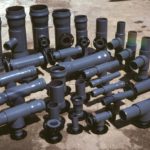A PVC flange, like flanges in general, is an essential component in piping systems for several reasons:
- Connection and Joint Integrity: A PVC flange serves as a connecting point between two pipes or other components in the piping system. It provides a secure and leak-proof joint, ensuring that fluids or gases flow without any losses or contamination.
- Easy Installation and Maintenance: Flanges simplify the installation and maintenance process. They allow for quick disconnection and reconnection of pipes, which is beneficial when repairs, replacements, or system modifications are necessary.
- Versatility: PVC flanges come in various types, sizes, and pressure ratings, making them versatile and suitable for a wide range of applications. They can handle different operating conditions and fluid types, providing flexibility in system design.
- Pressure Handling: Flanges are designed to handle high-pressure environments. When properly installed with the appropriate gaskets and bolts, they can withstand significant pressure, ensuring the safe operation of the piping system.
- Thermal Expansion: Piping systems often experience thermal expansion and contraction due to temperature changes. Flanges allow some movement at the joints, preventing undue stress on the pipes and reducing the risk of damage.
- Alignment: Flanges help in aligning and joining pipes precisely, ensuring smooth flow through the system and reducing the risk of blockages or turbulence.
- Accessibility for Inspection: Flanged connections facilitate easy access for inspection and testing of the piping system. This accessibility is crucial for routine maintenance and troubleshooting.
- Compatibility: PVC flanges are compatible with other PVC piping components and materials, providing a comprehensive and cohesive piping system design.
- Industry Standard: Flanges are widely used in piping systems across various industries, making them a standardized and reliable choice for engineers and installers.
- Safety: Properly installed flanges reduce the risk of leaks and potential hazards associated with fluid or gas leakage, ensuring a safer working environment.
In summary, a PVC flange is an important component in piping systems due to its role in providing secure connections, ease of installation and maintenance, pressure handling capabilities, thermal expansion accommodation, and overall contribution to the efficiency and safety of the system. If you are interested in PVC flanges or learn more about it, please contact 247Garden.com.
Why are you suppose to use a flange and not a coupling to connect a pvc pipe?
In PVC piping systems, both flanges and couplings serve different purposes and are used under different circumstances. The choice between using a flange and a coupling depends on the specific requirements of the application. Let's understand the differences and the scenarios where each is commonly used:
Flange:
- Strength and Rigidity: Flanges are generally more robust and rigid compared to couplings. They are designed to handle higher pressure and offer a more secure connection between pipes. Flanges are commonly used in applications where the system requires higher pressure handling.
- Bolted Connection: Flanges are connected using bolts and nuts, providing a more secure and leak-resistant joint. The bolted connection allows for easy disassembly and reassembly, making maintenance and repairs more straightforward.
- Large Pipes and High Pressure: Flanges are frequently used in larger diameter pipes and high-pressure systems where a strong, leak-proof joint is crucial.
- Industrial Applications: Flanges are common in industrial settings, such as chemical plants, refineries, and water treatment facilities, where durability and reliability are paramount.
Coupling:
- Flexibility: Couplings are more flexible and allow for some movement between connected pipes. They are suitable for applications where slight misalignment or movement due to thermal expansion/contraction is expected.
- Quick and Simple Installation: Couplings are easier and quicker to install than flanges. They do not require the use of bolts and nuts, which simplifies the assembly process.
- Smaller Pipes and Lower Pressure: Couplings are often used in smaller diameter pipes and lower-pressure systems. They are a cost-effective solution for non-critical applications.
- Plumbing and Residential Use: Couplings are commonly used in residential plumbing applications, such as connecting PVC pipes for drain lines or irrigation systems.
To summarize, you would choose a flange over a coupling when you need a stronger, more rigid, and leak-resistant joint for high-pressure or larger diameter pipes. On the other hand, if flexibility, ease of installation, and cost-effectiveness are more important for your application, then a coupling might be the better choice, especially in smaller diameter and lower-pressure systems. Each has its place in PVC piping systems, and the selection should be based on the specific requirements of the project.

